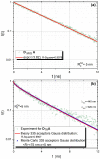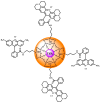New Core-Shell Nanostructures for FRET Studies: Synthesis, Characterization, and Quantitative Analysis
- PMID: 35328604
- PMCID: PMC8952644
- DOI: 10.3390/ijms23063182
New Core-Shell Nanostructures for FRET Studies: Synthesis, Characterization, and Quantitative Analysis
Abstract
This work describes the synthesis and characterization of new core-shell material designed for Förster resonance energy transfer (FRET) studies. Synthesis, structural and optical properties of core-shell nanostructures with a large number of two kinds of fluorophores bound to the shell are presented. As fluorophores, strongly fluorescent rhodamine 101 and rhodamine 110 chloride were selected. The dyes exhibit significant spectral overlap between acceptor absorption and donor emission spectra, which enables effective FRET. Core-shell nanoparticles strongly differing in the ratio of donors to acceptor numbers were prepared. This leads to two different interesting cases: typical single-step FRET or multistep energy migration preceding FRET. The single-step FRET model that was designed and presented by some of us recently for core-shell nanoparticles is herein experimentally verified. Very good agreement between the analytical expression for donor fluorescence intensity decay and experimental data was obtained, which confirmed the correctness of the model. Multistep energy migration between donors preceding the final transfer to the acceptor can also be successfully described. In this case, however, experimental data are compared with the results of Monte Carlo simulations, as there is no respective analytical expression. Excellent agreement in this more general case evidences the usefulness of this numerical method in the design and prediction of the properties of the synthesized core-shell nanoparticles labelled with multiple and chemically different fluorophores.
Keywords: FRET; TiO2@SiO2; core-shell nanostructures; luminescent materials.
Conflict of interest statement
The authors declare that they have no conflict of interest.
Figures









Similar articles
-
Core-shell nanoarchitectures: a strategy to improve the efficiency of luminescence resonance energy transfer.ACS Nano. 2010 Sep 28;4(9):5389-97. doi: 10.1021/nn100820u. ACS Nano. 2010. PMID: 20681528
-
Engineering the Compositional Architecture of Core-Shell Upconverting Lanthanide-Doped Nanoparticles for Optimal Luminescent Donor in Resonance Energy Transfer: The Effects of Energy Migration and Storage.Small. 2022 May;18(18):e2200464. doi: 10.1002/smll.202200464. Epub 2022 Mar 30. Small. 2022. PMID: 35355389
-
FRET-based small-molecule fluorescent probes: rational design and bioimaging applications.Acc Chem Res. 2013 Jul 16;46(7):1462-73. doi: 10.1021/ar300273v. Epub 2013 Feb 18. Acc Chem Res. 2013. PMID: 23419062
-
Förster resonance energy transfer investigations using quantum-dot fluorophores.Chemphyschem. 2006 Jan 16;7(1):47-57. doi: 10.1002/cphc.200500217. Chemphyschem. 2006. PMID: 16370019 Review.
-
Extensive use of FRET in biological imaging.Microscopy (Oxf). 2013 Aug;62(4):419-28. doi: 10.1093/jmicro/dft037. Microscopy (Oxf). 2013. PMID: 23797967 Review.
Cited by
-
General model of nonradiative excitation energy migration on a spherical nanoparticle with attached chromophores.Sci Rep. 2024 Mar 5;14(1):5479. doi: 10.1038/s41598-024-55193-4. Sci Rep. 2024. PMID: 38443509 Free PMC article.
References
-
- Kalambate P.K., Dhanjai, Huang Z., Li Y., Shen Y., Xie M., Huang Y., Srivastava A.K. Core@shell Nanomaterials Based Sensing Devices: A Review. TrAC Trends Anal. Chem. 2019;115:147–161. doi: 10.1016/j.trac.2019.04.002. - DOI
-
- Xing Q., Buono P., Ruch D., Dubois P., Wu L., Wang W.-J. Biodegradable UV-Blocking Films through Core–Shell Lignin–Melanin Nanoparticles in Poly(Butylene Adipate-Co-Terephthalate) ACS Sustain. Chem. Eng. 2019;7:4147–4157. doi: 10.1021/acssuschemeng.8b05755. - DOI
MeSH terms
Substances
Grants and funding
LinkOut - more resources
Full Text Sources
Research Materials

